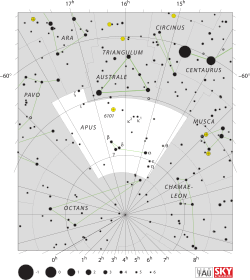Gamma Apodis
Gamma Apodis (γ Aps, γ Apodis) is the Bayer designation for a star in the southern circumpolar constellation of Apus. From parallax measurements, the distance to this star can be estimated as 150 ± 4 light-years (46.0 ± 1.2 pc).[4] It is visible to the naked eye with an apparent visual magnitude of 3.86.[2] A stellar classification of G9 III[2] identifies it as a giant star in the later stages of its evolution. It is an active X-ray source with a luminosity of 1.607 × 1030 erg s−1, making it one of the 100 strongest stellar X-ray sources within 50 parsecs of the Sun.[8]
 | |
| Observation data Epoch J2000 Equinox J2000 | |
|---|---|
| Constellation | Apus |
| Right ascension | 16h 33m 27.08379s[1] |
| Declination | −78° 53′ 49.7372″[1] |
| Apparent magnitude (V) | 3.86[2] |
| Characteristics | |
| Spectral type | G9 III[2] |
| U−B color index | +0.62[3] |
| B−V color index | +0.91[3] |
| Astrometry | |
| Radial velocity (Rv) | +5.7[2] km/s |
| Proper motion (μ) | RA: –126.122 ± 0.688[4] mas/yr Dec.: –78.699 ± 0.667[4] mas/yr |
| Parallax (π) | 21.7674 ± 0.5542[4] mas |
| Distance | 150 ± 4 ly (46 ± 1 pc) |
| Absolute magnitude (MV) | +0.41[5] |
| Details | |
| Surface gravity (log g) | 3.5[6] cgs |
| Temperature | 5,040[6] K |
| Metallicity [Fe/H] | –0.05[6] dex |
| Rotational velocity (v sin i) | 2.7[2] km/s |
| Other designations | |
| Database references | |
| SIMBAD | data |
Naming
In Chinese caused by adaptation of the European southern hemisphere constellations into the Chinese system, 異雀 (Yì Què), meaning Exotic Bird, refers to an asterism consisting of γ Apodis, ζ Apodis, ι Apodis, β Apodis, δ Octantis, δ1 Apodis, η Apodis, α Apodis and ε Apodis. Consequently, γ Apodis itself is known as 異雀四 (Yì Què sì, English: the Fourth Star of Exotic Bird).[9]
References
- van Leeuwen, F. (November 2007), "Validation of the new Hipparcos reduction", Astronomy and Astrophysics, 474 (2): 653–664, arXiv:0708.1752, Bibcode:2007A&A...474..653V, doi:10.1051/0004-6361:20078357.
- da Silva, L.; et al. (December 2009), "Search for associations containing young stars (SACY). III. Ages and Li abundances", Astronomy and Astrophysics, 508 (2): 833–839, arXiv:0909.0677, Bibcode:2009A&A...508..833D, doi:10.1051/0004-6361/200911736.
- Johnson, H. L.; et al. (1966), "UBVRIJKL photometry of the bright stars", Communications of the Lunar and Planetary Laboratory, 4 (99), Bibcode:1966CoLPL...4...99J.
- Brown, A. G. A.; et al. (Gaia collaboration) (August 2018). "Gaia Data Release 2: Summary of the contents and survey properties". Astronomy & Astrophysics. 616. A1. arXiv:1804.09365. Bibcode:2018A&A...616A...1G. doi:10.1051/0004-6361/201833051.
- Cardini, D. (January 2005), "Mg II chromospheric radiative loss rates in cool active and quiet stars", Astronomy and Astrophysics, 430: 303–311, arXiv:astro-ph/0409683, Bibcode:2005A&A...430..303C, doi:10.1051/0004-6361:20041440.
- Abia, C.; et al. (November 1988), "Abundances of light metals and NI in a sample of disc stars", Astronomy and Astrophysics, 206 (1): 100–107, Bibcode:1988A&A...206..100A.
- "gam Aps". SIMBAD. Centre de données astronomiques de Strasbourg. Retrieved 2012-06-29.
- Makarov, Valeri V. (October 2003), "The 100 Brightest X-Ray Stars within 50 Parsecs of the Sun", The Astronomical Journal, 126 (4): 1996–2008, Bibcode:2003AJ....126.1996M, doi:10.1086/378164.
- (in Chinese) AEEA (Activities of Exhibition and Education in Astronomy) 天文教育資訊網 2006 年 7 月 29 日